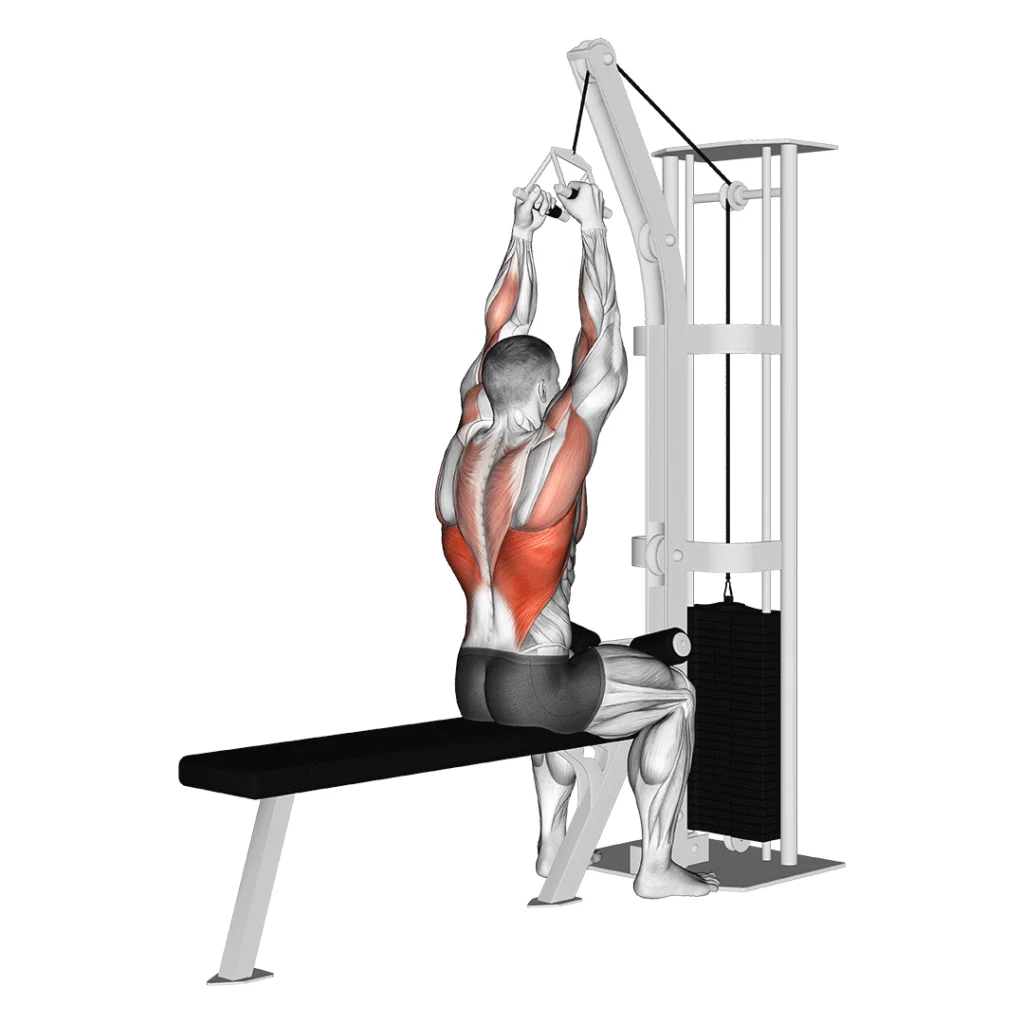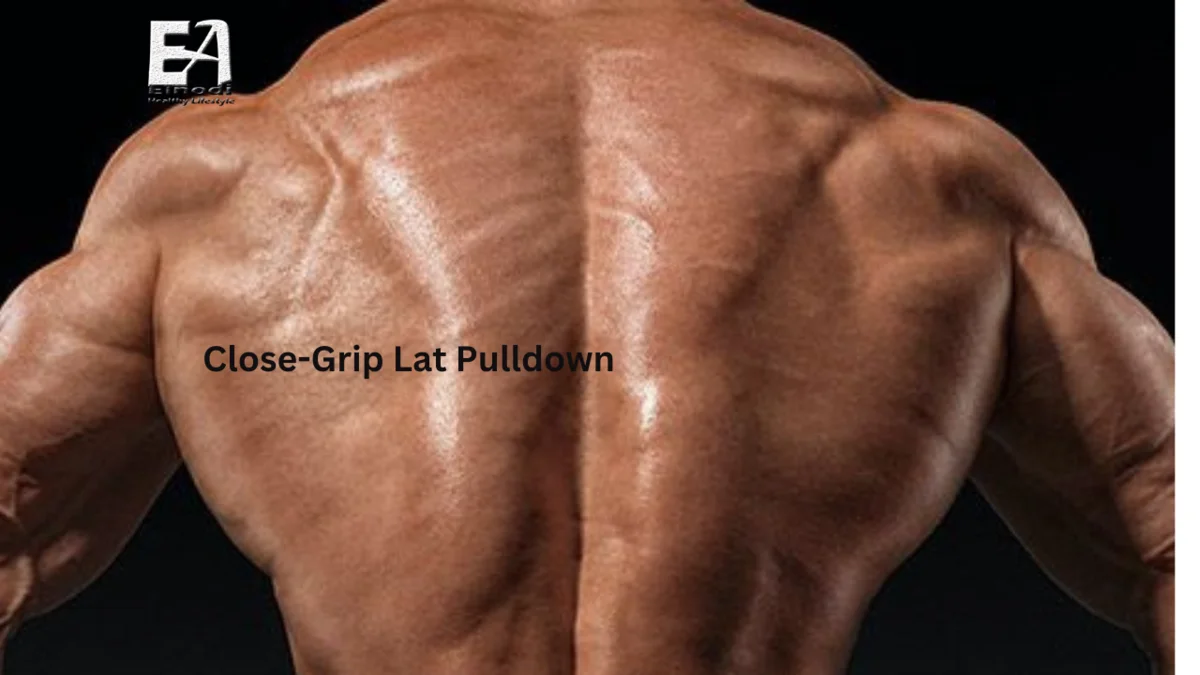the close-grip lat pulldown should exercise a fixture on every back day if you want a pair of wide lats to grow that v-taper.
A chin-up might be the most popular bodyweight exercise, but it’s not the only one that can give you a strong back. In fact, there’s another effective exercise for building a bigger back that you should know about – the Close-Grip Lat Pulldown.
Until now, lat pulldowns have been largely overlooked as an effective exercise for building a bigger back. But this has started to change in recent years with research indicating that they are an excellent tool for targeting the lats and developing a thicker back. (1, 2)
What is Close-Grip Lat Pulldown exercise
The Close-Grip Lat Pulldown is an effective exercise for targeting the lats and developing a thicker back. Contrary to popular belief, closing your grip on the lat bar does not decrease your range of motion or torque production. In fact, by gripping the bar close to your body you can increase these factors while also training your back muscles more effectively.
Benefits of Close-Grip Lat Pulldown Exercise
1. STRONGER AND BIGGER LATS
The close-grip lat pulldown provides a wider range of motion than the standard lat pulldown. You can drag the weight down a little bit more with the close grip connection than you would typically be able to with a broader grip.
As a result, you maximize your lat contraction at the end of each rep, which aids in developing a thicker, stronger back. Your success in sports, everyday tasks, and other compound exercises like the barbell row and the Pendlay row all benefit from having a strong back.
2. IMPROVED POSTURE
Hours of sitting in a chair at work or while driving might cause your lats and other back muscles to be underutilized. As a result, slouching, soreness, and strain in your shoulders and back may occur.
The close lat pulldown can help to strengthen these under-utilized muscles and reduce back pain or discomfort. With regular exercise and practice, you can correct your posture in no time.
3. INCREASED CONFIDENCE
While your lats perform most of the work, the close-grip lat pulldown also works your biceps. The biceps should allow you to pull down more weight than you typically could. This can give you the confidence you need to push through your workout.
That being said, although it’s always important to push yourself to the next level, be sure to use proper form to avoid risking injury!
Muscles worked Close-Grip Lat Pulldown

The close-grip lat pulldown targets mainly the same muscles as the wide-grip, including:
- Lats
- Mid-back
- Rhomboids
- Scapular stabilizing muscles
The close-grip pulldown will also include some abdominal work. Furthermore, if you are working with a heavier weight, your grip (and hence your forearms) will receive a decent workout.
How to do Close-Grip Lat Pulldown

Instructions
- Assume a seated position and attach a wide grip handle to the lat pulldown machine.
- Using a pronated grip (double underhand), grasp the handle at shoulder width.
- Begin by pushing the shoulder blades together and then flexing the elbow while extending the shoulder.
- Pull the handle closer to your body until your elbows are in line with your torso, then slowly drop the handle back to the starting position.
- Repeat until the desired number of repetitions has been reached.
Tips

- Maintain some tone in your abdominals as you pull the bar into your body to avoid excessive spine arching.
- Allow the weight to be controlled throughout each rep rather than allowing momentum to determine the action.
- Consider using a false grip (do not wrap your thumb over the dumbbell) if you feel your biceps are being overworked while your back is being underworked.
- Pulling should not cause the head to thrust forward.
- Likewise, ensure that the shoulder blade slides on the rib cage. Avoid locking the shoulder blade and simply move through the glenohumeral joint.
- At the height of the movement, allow the shoulder to internally rotate and shrug slightly. Obviously, you will reverse the movement and depress the shoulder blade before you pull with the arm.
Common Mistakes Close-Grip Pulldown
Using Momentum
The solid attachment of the thigh pad might make it all too tempting to cheat your form on any type of lat pulldown because it provides you something to leverage yourself against.
Using momentum to “swing” the handle down to your body, on the other hand, will not make you any stronger. It is a pointless exercise. Stay tight because loose posture and excess momentum relieve some of the mechanical tension that perfect form places on your back muscles in the first place.
Pulling Too Low
There is such a thing as too much of a good thing when it comes to the close-grip pulldown. Some gymgoers may be tempted to keep lowering the handle after their upper arms have already been tucked into their sides.
Not only does this do nothing for your back muscles, but it may also in some cases add unwanted stress to your wrists, elbows, or shoulders.
You have fully engaged your lats when your arms tuck into your sides and have nothing to gain by drawing deeper.
Using Your Arms
The biceps and brachialis muscles help your upper back during the close-grip pulldown, but they should not take center stage.
Try to mentally disconnect yourself from the notion that you must use your arms to pull the weight. Instead, as you begin each rep, consider “leading with your shoulder.” As you draw, your shoulders should descend and then elevate as you return the handle to the beginning position.
Close-Grip Pulldown Variations
1. Reverse Grip Lat Pull Down
The reverse close-grip lat pulldown necessitates greater core stability and muscle-mind connection. Begin by removing yourself from the lat pulldown machine. Extend your arms upwards, palms facing each other, to grab the close grip attachment.
Brace your core, draw your shoulder blades down and back, and pull the attachment down until it meets your chest while leaning slightly back. Slowly return to the starting position after a little pause at the bottom. Maintain core tightness and repeat!
2. Supinated Lat Pulldown
Another variation that works the biceps more than the typical lat pulldown is the supinated lat pulldown. To begin, take a seat on the bench facing the cable machine. Extend your arms overhead, palms facing you, to hold the lat pulldown bar.
Hands should be around shoulder width apart. Brace your core, push your shoulder blades down and back, and drag the bar down until it meets the top of your rib cage while gently leaning back.
Pause briefly at the bottom, squeeze your lats, and slowly return to the starting position. Maintain tightness in your core and repeat!
3. Alternating Lat pulldown (With handles)
The alternating lat pulldown can also be used to exercise your lats unilaterally. To begin, take a seat on the bench facing the cable machine. Extend your arms upwards, palms facing front, to hold the handles.
Contract your right lat to pull the right handle down. Then, complete the same motion on the left side. Slowly return each handle to the starting position and repeat!
FAQ
what is the difference between a close grip pulldown and a lat pulldown?
what grip is best for close grip pulldown?
what does close grip reverse lat pulldown work?
References
1. SIGNORILE, J. E., Zink, A. J., & Szwed, S. P. (2002). A comparative electromyographical investigation of muscle utilization patterns using various hand positions during the lat pull-down. The Journal of Strength & Conditioning Research, 16(4), 539-546.
2. Crate, T. (1997). Analysis of the lat pulldown. Strength & Conditioning Journal, 19(3), 26-29.





